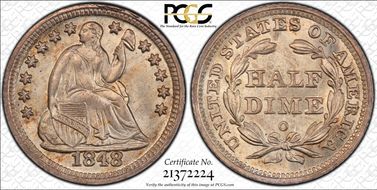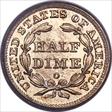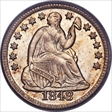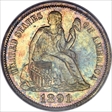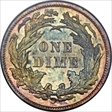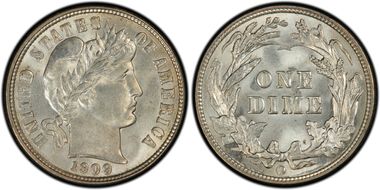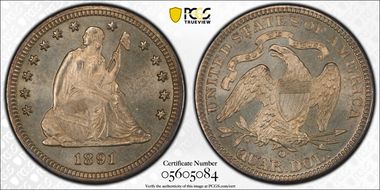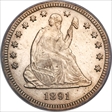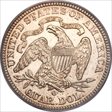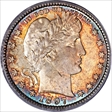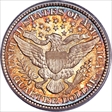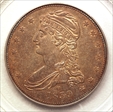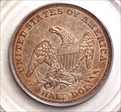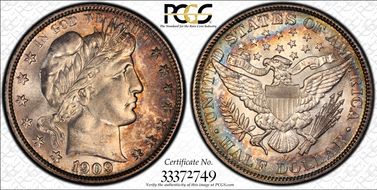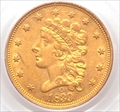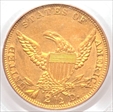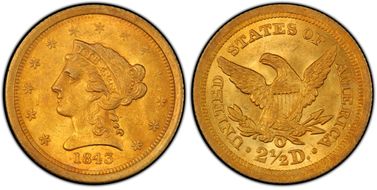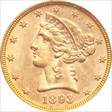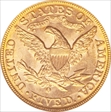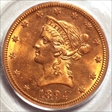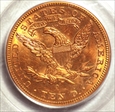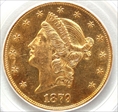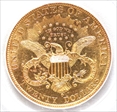Wind River Collection 的钱币相册
The 1848-O half dime it is one of the more common dates of this type. This coin is a Valentine-2 (V-2) with a small O mint mark which is the scarcest of the three mint mark sizes. It was purchased from the Gardner collection and is one of the finest know half dimes of this date. A landmark article on the eight different 1848-O die varieties was published by Bill Harmon in the Gobrecht Journal (#56) making this date one of the more popular ones to collect by die variety.
The 1848-O half dime it is one of the more common dates of this type. This coin is a Valentine-2 (V-2) with a small O mint mark which is the scarcest of the three mint mark sizes. It was purchased from the Gardner collection and is one of the finest know half dimes of this date. A landmark article on the eight different 1848-O die varieties was published by Bill Harmon in the Gobrecht Journal (#56) making this date one of the more popular ones to collect by die variety.
The 1848-O half dime it is one of the more common dates of this type. This coin is a Valentine-2 (V-2) with a small O mint mark which is the scarcest of the three mint mark sizes. It was purchased from the Gardner collection and is one of the finest know half dimes of this date. A landmark article on the eight different 1848-O die varieties was published by Bill Harmon in the Gobrecht Journal (#56) making this date one of the more popular ones to collect by die variety.
The "with legend" seated dime was minted at Philadelphia for 32 years, but was only minted at New Orleans for two years: 1860 and 1891, the first and last years of the design type. The 1860-O dime is quite rare and virtually unobtainable in uncirculated condition, but the 1891-O is readily available in all grades through gem condition. This coin was purchased from the Gene Gardner auction which I consider the best Seated coin collection ever assembled. Gerry Fortin, in his comprehensive Liberty Seated Dime Variety Web-Book, has documented 32 different 1891-O die varieties with more yet to be published. Many of these dimes have dramatic cracks, die clashing, cuds and other indications of die damage apparently due to mint employee inexperience and coin presses designed for larger coins, primarily Morgan dollars.
The "with legend" seated dime was minted at Philadelphia for 32 years, but was only minted at New Orleans for two years: 1860 and 1891, the first and last years of the design type. The 1860-O dime is quite rare and virtually unobtainable in uncirculated condition, but the 1891-O is readily available in all grades through gem condition. This coin was purchased from the Gene Gardner auction which I consider the best Seated coin collection ever assembled. Gerry Fortin, in his comprehensive Liberty Seated Dime Variety Web-Book, has documented 32 different 1891-O die varieties with more yet to be published. Many of these dimes have dramatic cracks, die clashing, cuds and other indications of die damage apparently due to mint employee inexperience and coin presses designed for larger coins, primarily Morgan dollars.
The last year of dime production, or any coin production, at the New Orleans Mint was 1909. The mint had been reopened in 1879 primarily to manufacture silver dollars, but other denominations were sporadically produced until 1909 when the mint was closed. Barber dimes, quarters, and half dollars were minted at New Orleans in 1909 along with the Indian Head half eagle. For New Orleans Barber dimes, the 1909-O is a slightly better date, but not nearly as rare as most of those produced in the 19th century. This 1909-O dime came from the "Lily Nicole" collection.
The "with motto" seated quarter was produced at the New Orleans mint for only one year, 1891, and in very limited quantities (68 thousand mintage). As such, it is scarce in lower circulated grades and rare in AU to uncirculated grades. This coin came from the Gardner collection and is tied for the second highest graded by PCGS.
The "with motto" seated quarter was produced at the New Orleans mint for only one year, 1891, and in very limited quantities (68 thousand mintage). As such, it is scarce in lower circulated grades and rare in AU to uncirculated grades. This coin came from the Gardner collection and is tied for the second highest graded by PCGS.
The "with motto" seated quarter was produced at the New Orleans mint for only one year, 1891, and in very limited quantities (68 thousand mintage). As such, it is scarce in lower circulated grades and rare in AU to uncirculated grades. This coin came from the Gardner collection and is tied for the second highest graded by PCGS.
GR-4 non-rotated reverse.CAC This is the only Bust coin produced for ciculation at the New Orleans mint. For years it seemed like an 1839-O half dollar could be found at any coin show, but it has been much harder to find in recent times. I suspect that there is some hoarding this date. In Jules Reiver's guide on reeded edge bust half dollars he described two die marriages for the 1839-O half dollar. A supplement later listed a third variety. The first variety, JR-1, usually with encircling die cracks through the obverse stars and the reverse lettering, is by far the most common variety. This coin, which is a JR-2 is much scarcer, but can still be found with diligent searching. Early die state coins of the JR-2 variety are usually found with a 180 degree "reverse" rotation (aka medal turn). In 2012 Dick Graham published "A Registry of Die Varieties of Reeded Edge Half Dollars" that included an additional two varieties that are/were unique based on the author's extensive research up to the publication date.
GR-4 non-rotated reverse.CAC This is the only Bust coin produced for ciculation at the New Orleans mint. For years it seemed like an 1839-O half dollar could be found at any coin show, but it has been much harder to find in recent times. I suspect that there is some hoarding this date. In Jules Reiver's guide on reeded edge bust half dollars he described two die marriages for the 1839-O half dollar. A supplement later listed a third variety. The first variety, JR-1, usually with encircling die cracks through the obverse stars and the reverse lettering, is by far the most common variety. This coin, which is a JR-2 is much scarcer, but can still be found with diligent searching. Early die state coins of the JR-2 variety are usually found with a 180 degree "reverse" rotation (aka medal turn). In 2012 Dick Graham published "A Registry of Die Varieties of Reeded Edge Half Dollars" that included an additional two varieties that are/were unique based on the author's extensive research up to the publication date.
Like the Barber dimes and quarters no circulating issues can really be considered rare. The rarest New Orleans Barber half the 1896-O which rivals the 1904-S as the rarest date in the series. One of my favorite dates is the 1909-O represented in this collection. It was the final year of production at the New Orleans mint, which had apparently outlived its usefulness for producing coins.
The 1860-O dollar is the most common date of all Seated dollars and had one of the higher mintages in the series. This was a common date before the great silver dollar release, which peaked in the early 1960s. Even though relatively common before this time, several bags of 1860-O dollars were released during the great sliver release of the 1950-S and the 1960s making it the prototypical Seated dollar type coin. However, in MS-64, this coin become scarce.
The 1839-O quarter eagle is another one-year type for the New Orleans mint with two varieties: the close fraction and the wide fraction. John McCloskey, the recently retired president of the Liberty Seated Collector's Club for 40 years, has studied classic quarter eagles for many years. He confirmed that all rotated reverse 1839-O quarter eagles, as this one is, are the close fraction reverse which is a bit scarcer. Since this rotated reverse was the normal mode of production for this die marriage and for several other die marriages during the early years of coin production at the New Orleans mint, these coins should not be considered errors.
The 1839-O quarter eagle is another one-year type for the New Orleans mint with two varieties: the close fraction and the wide fraction. John McCloskey, the recently retired president of the Liberty Seated Collector's Club for 40 years, has studied classic quarter eagles for many years. He confirmed that all rotated reverse 1839-O quarter eagles, as this one is, are the close fraction reverse which is a bit scarcer. Since this rotated reverse was the normal mode of production for this die marriage and for several other die marriages during the early years of coin production at the New Orleans mint, these coins should not be considered errors.
When I first started collecting New Orleans coins, I tended to consider Liberty half eagles and eagles together because they are essentially the same design and differ primarily by denomination. This is where the similarity ends, at least for New Orleans issues. There are only three dates for the with motto Liberty half eagles, but sixteen for the eagles. Less than 600 half eagles have been certified by PCGS as of June 2015 with more than 10 times that amount certified for the with motto eagles. The 1892-O is by far the rarest of the three dates and the 1893-O is the most common. In MS-63 the 1893-O, which is represented in this set, is quite scarce and the other dates are rare. Higher grades for this type are virtually non-existent.
When I first started collecting New Orleans coins, I tended to consider Liberty half eagles and eagles together because they are essentially the same design and differ primarily by denomination. This is where the similarity ends, at least for New Orleans issues. There are only three dates for the with motto Liberty half eagles, but sixteen for the eagles. Less than 600 half eagles have been certified by PCGS as of June 2015 with more than 10 times that amount certified for the with motto eagles. The 1892-O is by far the rarest of the three dates and the 1893-O is the most common. In MS-63 the 1893-O, which is represented in this set, is quite scarce and the other dates are rare. Higher grades for this type are virtually non-existent.
When I first started collecting New Orleans coins, I tended to consider Liberty half eagles and eagles together because they are essentially the same design and differ primarily by denomination. This is where the similarity ends, at least for New Orleans issues. There are only three dates for the with motto Liberty half eagles, but sixteen for the eagles. Less than 600 half eagles have been certified by PCGS as of June 2015 with more than 10 times that amount certified for the with motto eagles. The 1892-O is by far the rarest of the three dates and the 1893-O is the most common. In MS-63 the 1893-O, which is represented in this set, is quite scarce and the other dates are rare. Higher grades for this type are virtually non-existent.
The "with motto" eagles are one of the few New Orleans gold type coins that are regularly available in uncirculated grades apparently due to significant numbers that had been stored in Europe and "rediscovered" in recent years. As such the prices are quite reasonable for most dates after 1883. However, most of these coins are MS-60 to MS-62. They quickly become scarce to rare starting with MS-63 due to their weight and the softness of the gold alloy causing numerous bagmarks during their long visit abroad.
The "with motto" eagles are one of the few New Orleans gold type coins that are regularly available in uncirculated grades apparently due to significant numbers that had been stored in Europe and "rediscovered" in recent years. As such the prices are quite reasonable for most dates after 1883. However, most of these coins are MS-60 to MS-62. They quickly become scarce to rare starting with MS-63 due to their weight and the softness of the gold alloy causing numerous bagmarks during their long visit abroad.
As with thirteen other New Orleans type coins, this one is represented by only one year of production: 1879. The mintage of 2,325 pieces is the second lowest for all New Orleans double eagles and the lowest total mintage for any New Orleans type coin. This was the ultimate coin needed for my New Orleans type set. I had owned one previously, but could not get it graded as a problem free coin so I finally sold it. However, this coin showed up at Stack's several years ago and I was able to purchase it to complete my type set.
As with thirteen other New Orleans type coins, this one is represented by only one year of production: 1879. The mintage of 2,325 pieces is the second lowest for all New Orleans double eagles and the lowest total mintage for any New Orleans type coin. This was the ultimate coin needed for my New Orleans type set. I had owned one previously, but could not get it graded as a problem free coin so I finally sold it. However, this coin showed up at Stack's several years ago and I was able to purchase it to complete my type set.




















